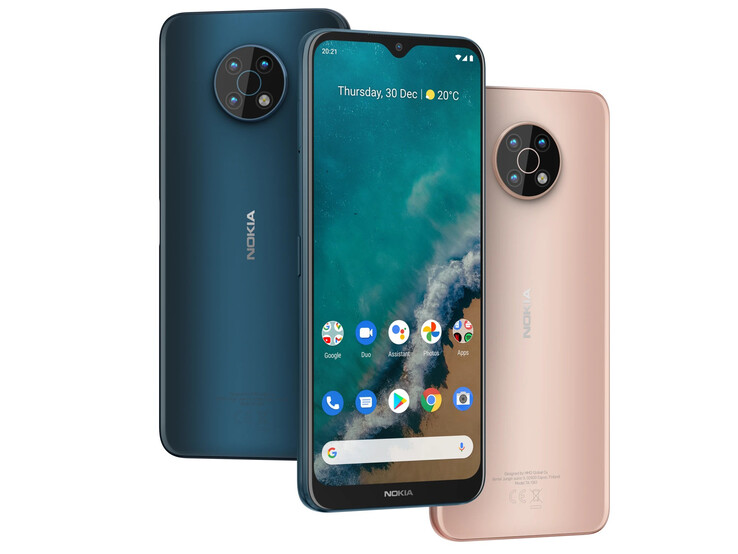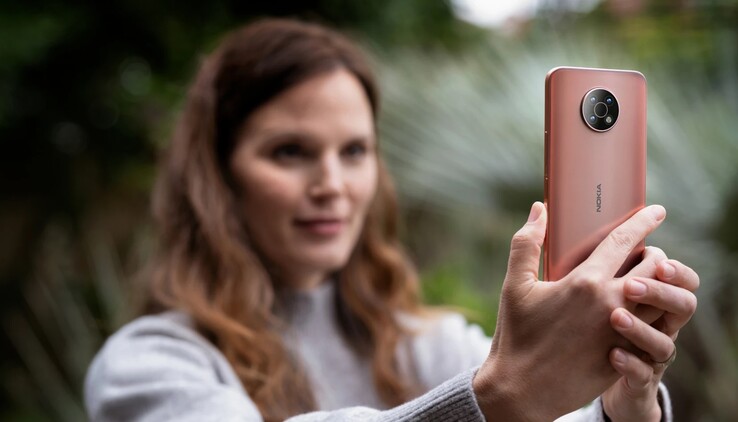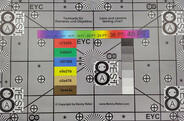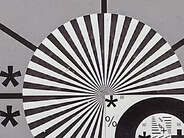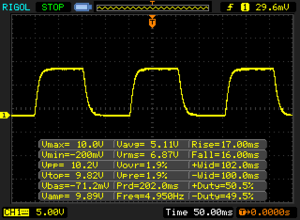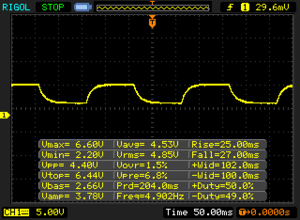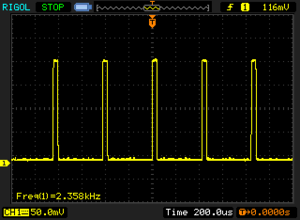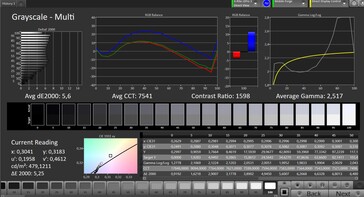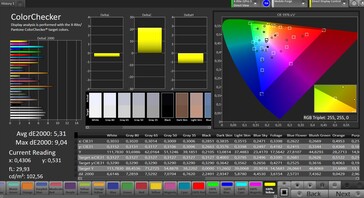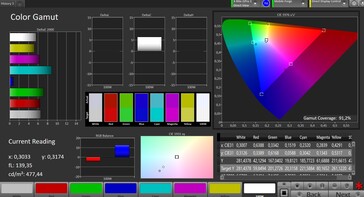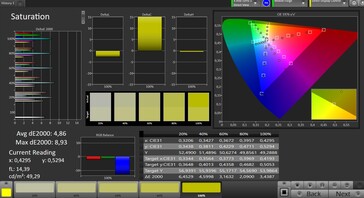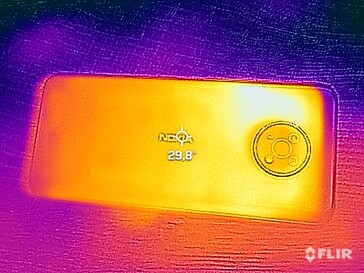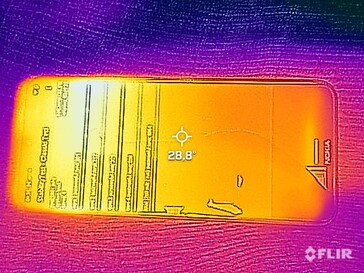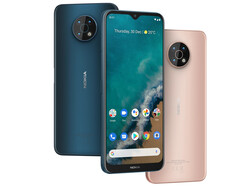Nokia G50 smartphone review - 3-year update for the mid-range phone
Possible competitors in comparison
Bewertung | Datum | Modell | Gewicht | Laufwerk | Groesse | Aufloesung | Preis ab |
|---|---|---|---|---|---|---|---|
| 78.5 % | 11/2021 | Nokia G50 SD 480, Adreno 619 | 220 g | 128 GB UFS 2.1 Flash | 6.82" | 1560x720 | |
| 81.1 % | 06/2021 | Xiaomi Redmi Note 10S Helio G95, Mali-G76 MP4 | 178.8 g | 128 GB UFS 2.2 Flash | 6.43" | 2400x1080 | |
| 80.9 % | 09/2021 | Motorola Moto G60s Helio G95, Mali-G76 MP4 | 212 g | 128 GB UFS 2.1 Flash | 6.80" | 2480x1080 | |
| 79.3 % | 03/2021 | Samsung Galaxy A32 5G Dimensity 720, Mali-G57 MP3 | 205 g | 64 GB UFS 2.1 Flash | 6.50" | 1600x720 |
Case and equipment - Chic with a lot of memory
If you compare the Nokia G50 with the slightly more expensive Nokia X10, the only differences are in the details: a lower-resolution screen in the G50, as well as the lack of IP certification and a macro lens. The Nokia X10 is a bit smaller, but weighs just as much as the G50, with a smaller battery.
The plastic back casing is available in a dazzling blue or rosé. The design is pleasing and also unusual with the round camera module. The stability is decent. The Nokia G50 is quite a big smartphone and also a bit heavier than comparable devices.
A 64 GB variant is also available, but only the model with 128 GB of mass storage and 4 GB of RAM is currently available in Central Europe. Officially, the device costs just under 270 Euros (~$304). For this money, you get a USB-C port, a 3.5 mm audio port, NFC, and 2 SIM slots, one of which can also be used as a microSD reader. We tested the reader's speed with our reference card Angelbird V60. It is on par with the class, but does not stand out from other devices.
| SD Card Reader - average JPG Copy Test (av. of 3 runs) | |
| Average of class Smartphone (10.9 - 77, n=99, last 2 years) | |
| Motorola Moto G60s (Angelbird V60) | |
| Nokia G50 (Angelbird V60) | |
| Xiaomi Redmi Note 10S (Toshiba Exceria Pro M501) | |
Cross Platform Disk Test (CPDT)
Communication, software and operation - 5G in the Nokia G50
The Nokia G50 can keep up with other smartphones in this price range in terms of Wi-Fi speed and provides sufficiently fast Internet for everyday use thanks to Wi-Fi 5. 5G is not yet a matter of course in this price range, but Nokia's G50 can deliver. The smartphone is sufficient for 4G frequencies, but it is clearly not a world phone that can be used everywhere.
Nokia's G50 is part of the Android-One program, which makes updates for the operating system particularly easy by staying quite close to Google's Vanilla Android. Thus, Nokia is able to guarantee 2 years of operating system updates and 3 years of security updates even for the relatively cheap smartphone. The periods are valid from the G50's market launch. The security updates on our test device are from October 2021 and thus quite up-to-date at the time of testing.
A dedicated Google Assistant button is found on the casing's left, and a fingerprint sensor is integrated into the standby button on the right. It works reliably and quite quickly.
| Networking | |
| iperf3 transmit AX12 | |
| Motorola Moto G60s | |
| Samsung Galaxy A32 5G | |
| Nokia G50 | |
| Xiaomi Redmi Note 10S | |
| iperf3 receive AX12 | |
| Samsung Galaxy A32 5G | |
| Nokia G50 | |
| Motorola Moto G60s | |
| Xiaomi Redmi Note 10S | |
Cameras - Not exactly sharp
The G50 does not have the ZEISS label on its camera, as the more expensive Nokia X models do, but the technical specifications of the cameras are otherwise quite similar to those of the Nokia X10. A 48-megapixel main camera, which collects more light if desired thanks to pixel binning, but then only takes 12-megapixel pictures. In addition, there is a 5MP wide-angle lens and a 2MP depth sensor to assist. However, there is no macro camera in the G50.
The main camera takes passable photos, but they look quite grainy in detail and sometimes clearly washed out. In low light and high contrasts, there is a lack of dynamics in the dark areas, but details are still quite sharp. A wide-angle camera is also on board; it is sufficient for snapshots, but you should not enlarge the pictures too much.
The front-facing camera takes usable selfies in good light, where some details are still visible.
Image Comparison
Choose a scene and navigate within the first image. One click changes the position on touchscreens. One click on the zoomed-in image opens the original in a new window. The first image shows the scaled photograph of the test device.
Main camera PlantMain camera LandscapeWide-angle camera Low LightWide-angle camera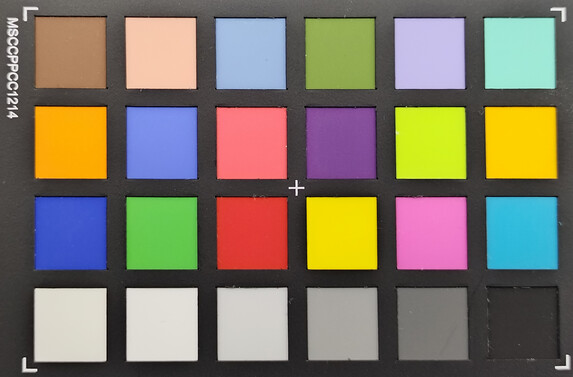
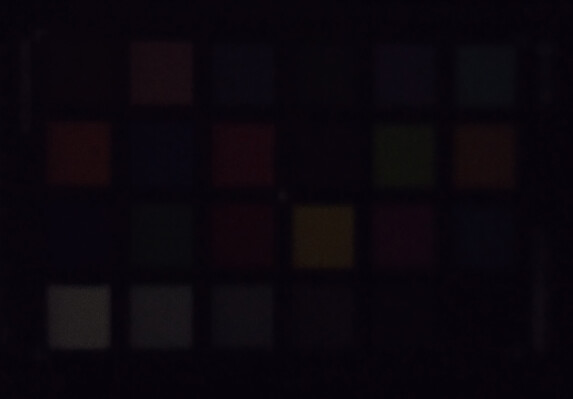
Display - IPS screen with low resolution
The IPS screen with an extended 720p resolution will probably not be the champion in terms of luminosity or color reproduction according to our test results, but there is the Redmi Note 10S with its Full HD AMOLED screen.
However, the screen of Nokia's G50 also puts up a good fight. It is decently bright with 525 cd/m² when desired and even offers a pretty good black level, which in turn raises the contrast ratio to a high level.
It is also pleasing that we only notice PWM at very low brightness with such a high frequency that it should not cause any problems for anyone.
| |||||||||||||||||||||||||
Brightness Distribution: 85 %
Center on Battery: 568 cd/m²
Contrast: 2367:1 (Black: 0.24 cd/m²)
ΔE Color 5.31 | 0.5-29.43 Ø5
ΔE Greyscale 5.6 | 0.57-98 Ø5.3
91.2% sRGB (Calman 2D)
Gamma: 2.517
| Nokia G50 IPS, 1560x720, 6.82 | Xiaomi Redmi Note 10S AMOLED, 2400x1080, 6.43 | Motorola Moto G60s IPS, 2480x1080, 6.80 | Samsung Galaxy A32 5G TFT-LCD, 1600x720, 6.50 | |
|---|---|---|---|---|
| Response Times | 26% | 30% | -26% | |
| Response Time Grey 50% / Grey 80% * | 52 ? | 4.8 ? 91% | 38 ? 27% | 66.8 ? -28% |
| Response Time Black / White * | 33 ? | 4 ? 88% | 22 ? 33% | 40.8 ? -24% |
| PWM Frequency | 2358000 ? | 250 ? -100% | ||
| Screen | 42% | -1% | -29% | |
| Brightness middle | 568 | 706 24% | 602 6% | 543 -4% |
| Brightness | 525 | 701 34% | 564 7% | 512 -2% |
| Brightness Distribution | 85 | 98 15% | 83 -2% | 85 0% |
| Black Level * | 0.24 | 0.56 -133% | 0.63 -163% | |
| Contrast | 2367 | 1075 -55% | 862 -64% | |
| Colorchecker dE 2000 * | 5.31 | 2.1 60% | 2.23 58% | 4.9 8% |
| Colorchecker dE 2000 max. * | 9.04 | 4.9 46% | 3.99 56% | 8.6 5% |
| Greyscale dE 2000 * | 5.6 | 1.5 73% | 2.6 54% | 6.3 -13% |
| Gamma | 2.517 87% | 2.29 96% | 2.32 95% | 2.23 99% |
| CCT | 7541 86% | 6447 101% | 7127 91% | 8120 80% |
| Total Average (Program / Settings) | 34% /
37% | 15% /
5% | -28% /
-29% |
* ... smaller is better
Display Response Times
| ↔ Response Time Black to White | ||
|---|---|---|
| 33 ms ... rise ↗ and fall ↘ combined | ↗ 17 ms rise | |
| ↘ 16 ms fall | ||
| The screen shows slow response rates in our tests and will be unsatisfactory for gamers. In comparison, all tested devices range from 0.1 (minimum) to 240 (maximum) ms. » 88 % of all devices are better. This means that the measured response time is worse than the average of all tested devices (21.5 ms). | ||
| ↔ Response Time 50% Grey to 80% Grey | ||
| 52 ms ... rise ↗ and fall ↘ combined | ↗ 25 ms rise | |
| ↘ 27 ms fall | ||
| The screen shows slow response rates in our tests and will be unsatisfactory for gamers. In comparison, all tested devices range from 0.2 (minimum) to 636 (maximum) ms. » 87 % of all devices are better. This means that the measured response time is worse than the average of all tested devices (33.7 ms). | ||
Screen Flickering / PWM (Pulse-Width Modulation)
| Screen flickering / PWM detected | 2358000 Hz | ≤ 15 % brightness setting | |
The display backlight flickers at 2358000 Hz (worst case, e.g., utilizing PWM) Flickering detected at a brightness setting of 15 % and below. There should be no flickering or PWM above this brightness setting. The frequency of 2358000 Hz is quite high, so most users sensitive to PWM should not notice any flickering. In comparison: 53 % of all tested devices do not use PWM to dim the display. If PWM was detected, an average of 17903 (minimum: 5 - maximum: 3846000) Hz was measured. | |||
Performance, emissions and battery life - graphics performance falls off
The Snapdragon 480 is found in many Nokia devices, which is probably due to the chip shortage: The manufacturer has simply secured large quantities of the quite universally usable SoC. In Nokia's G50, it actually also supplies suitable computing power for the price range, but it falls behind comparable devices in terms of graphics performance, with a partly lower-resolution screen. Thus, users who play a lot and want as much power as possible for their money should look elsewhere.
Fortunately, the maximum temperature rise is quite low: 36.6 °C (97.9 °F) as the absolute maximum is slightly noticeable, but not problematic. The mono speaker in Nokia's G50 is quite loud in our test, but the sound is rather poor with a lack of low mids and booming highs at high volumes. At least all current codecs including aptX Adaptive can be used via Bluetooth.
Nokia's G50 comes with a 5,000 mAh battery, as is found in many devices in this price range. What the phone gets out of its battery in terms of runtimes is mediocre compared to other devices. However, 16:12 hours in our WLAN test are still very suitable for everyday use and should also be sufficient for 2 workdays with normal use. The smartphone can be charged with a maximum of 10 watts, which means that the charging process sometimes takes over 2 hours.
| GFXBench | |
| on screen Aztec Ruins Normal Tier Onscreen (sort by value) | |
| Nokia G50 | |
| Xiaomi Redmi Note 10S | |
| Motorola Moto G60s | |
| Samsung Galaxy A32 5G | |
| Average Qualcomm Snapdragon 480 5G (16 - 31, n=9) | |
| Average of class Smartphone (3.6 - 123, n=227, last 2 years) | |
| 1920x1080 Aztec Ruins Normal Tier Offscreen (sort by value) | |
| Nokia G50 | |
| Xiaomi Redmi Note 10S | |
| Motorola Moto G60s | |
| Samsung Galaxy A32 5G | |
| Average Qualcomm Snapdragon 480 5G (17 - 19, n=9) | |
| Average of class Smartphone (2.3 - 229, n=227, last 2 years) | |
| on screen Aztec Ruins High Tier Onscreen (sort by value) | |
| Nokia G50 | |
| Xiaomi Redmi Note 10S | |
| Motorola Moto G60s | |
| Samsung Galaxy A32 5G | |
| Average Qualcomm Snapdragon 480 5G (9.9 - 19, n=9) | |
| Average of class Smartphone (2.8 - 119, n=227, last 2 years) | |
| 2560x1440 Aztec Ruins High Tier Offscreen (sort by value) | |
| Nokia G50 | |
| Xiaomi Redmi Note 10S | |
| Motorola Moto G60s | |
| Samsung Galaxy A32 5G | |
| Average Qualcomm Snapdragon 480 5G (6.4 - 6.7, n=9) | |
| Average of class Smartphone (0.85 - 94, n=227, last 2 years) | |
| Nokia G50 | Xiaomi Redmi Note 10S | Motorola Moto G60s | Samsung Galaxy A32 5G | Average 128 GB UFS 2.1 Flash | Average of class Smartphone | |
|---|---|---|---|---|---|---|
| AndroBench 3-5 | -23% | -28% | 10% | -7% | 105% | |
| Sequential Read 256KB | 515 | 498.8 -3% | 498.5 -3% | 858 67% | 760 ? 48% | 1506 ? 192% |
| Sequential Write 256KB | 486.6 | 372 -24% | 200.5 -59% | 381.7 -22% | 297 ? -39% | 1115 ? 129% |
| Random Read 4KB | 182 | 110.5 -39% | 123.3 -32% | 174.6 -4% | 152.9 ? -16% | 247 ? 36% |
| Random Write 4KB | 166.5 | 121 -27% | 135.3 -19% | 167.1 0% | 131.6 ? -21% | 271 ? 63% |
Temperature
(+) The maximum temperature on the upper side is 36.1 °C / 97 F, compared to the average of 35 °C / 95 F, ranging from 21.9 to 56 °C for the class Smartphone.
(+) The bottom heats up to a maximum of 36.6 °C / 98 F, compared to the average of 33.8 °C / 93 F
(+) In idle usage, the average temperature for the upper side is 22 °C / 72 F, compared to the device average of 32.7 °C / 91 F.
Speaker
Nokia G50 audio analysis
(+) | speakers can play relatively loud (87.7 dB)
Bass 100 - 315 Hz
(-) | nearly no bass - on average 29.6% lower than median
(±) | linearity of bass is average (8.8% delta to prev. frequency)
Mids 400 - 2000 Hz
(±) | higher mids - on average 6.4% higher than median
(+) | mids are linear (6.9% delta to prev. frequency)
Highs 2 - 16 kHz
(+) | balanced highs - only 3.5% away from median
(±) | linearity of highs is average (7.2% delta to prev. frequency)
Overall 100 - 16.000 Hz
(±) | linearity of overall sound is average (23.1% difference to median)
Compared to same class
» 45% of all tested devices in this class were better, 7% similar, 47% worse
» The best had a delta of 12%, average was 38%, worst was 134%
Compared to all devices tested
» 64% of all tested devices were better, 6% similar, 30% worse
» The best had a delta of 4%, average was 25%, worst was 134%
Xiaomi Redmi Note 10S audio analysis
(+) | speakers can play relatively loud (88.9 dB)
Bass 100 - 315 Hz
(-) | nearly no bass - on average 33.4% lower than median
(±) | linearity of bass is average (9.6% delta to prev. frequency)
Mids 400 - 2000 Hz
(±) | reduced mids - on average 5.9% lower than median
(+) | mids are linear (5.2% delta to prev. frequency)
Highs 2 - 16 kHz
(+) | balanced highs - only 4.3% away from median
(+) | highs are linear (2.9% delta to prev. frequency)
Overall 100 - 16.000 Hz
(±) | linearity of overall sound is average (20.3% difference to median)
Compared to same class
» 27% of all tested devices in this class were better, 9% similar, 64% worse
» The best had a delta of 12%, average was 38%, worst was 134%
Compared to all devices tested
» 47% of all tested devices were better, 8% similar, 44% worse
» The best had a delta of 4%, average was 25%, worst was 134%
Battery life
| Nokia G50 5000 mAh | Xiaomi Redmi Note 10S 5000 mAh | Motorola Moto G60s 5000 mAh | Samsung Galaxy A32 5G 5000 mAh | Average of class Smartphone | |
|---|---|---|---|---|---|
| Battery Runtime | |||||
| WiFi Websurfing | 972 | 1087 12% | 763 -22% | 1235 27% | 914 ? -6% |
Pros
Cons
Verdict - Good average with 5G
The casing of Nokia's G50 is stylishly designed and quite sturdy, you have to hand it to the Finns. At the same time, the smartphone's fast Internet and 5G capability are convincing.
Nokia's G50 is a solid mid-range smartphone that can stay with the user for a bit longer thanks to the update promise.
However, the smartphone lags behind comparable phones in graphics calculations. The Nokia G50 is relatively heavy and the battery does not last quite as long as other smartphones in the price range. The camera is not really convincing due to blurry details and rough surface drawing.
Overall, Nokia delivers a solid, relatively inexpensive mid-range device with 5G, but it is a bit overshadowed by the competition: The Redmi Note 10S does not offer 5G, but it has a much finer screen with AMOLED technology and Full HD. With the Samsung Galaxy A32 5G you get much longer runtimes and a better speaker.
Price and availability
You can get the Nokia G50 directly from the manufacturer at https://www.nokia.com/phones/de_de/nokia-g-50?sku=F16BYA1022033. It is a few Euros cheaper if you look around on the Internet, for example at our loaner Cyberport, at notebooksbilliger.de or at Amazon (US).
Nokia G50
-
11/19/2021 v7
Florian Schmitt


 Deutsch
Deutsch English
English Español
Español Français
Français Italiano
Italiano Nederlands
Nederlands Polski
Polski Português
Português Русский
Русский Türkçe
Türkçe Svenska
Svenska Chinese
Chinese Magyar
Magyar